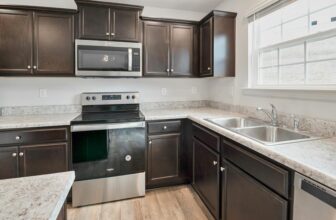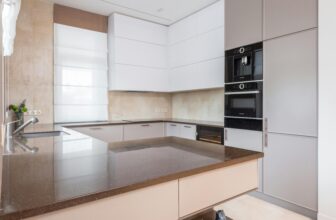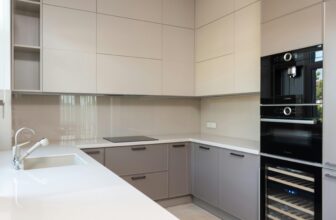Small kitchens present unique challenges when selecting cooking appliances, but smart wall oven solutions can deliver full functionality without overwhelming limited space. Modern compact and combination units prove that size doesn’t have to limit culinary ambitions. Before exploring space-saving options, review our complete wall oven buying guide to understand all available features and configurations.
Understanding Compact Wall Oven Options
Compact wall ovens typically measure 24 inches wide or less, compared to standard 30-inch models. Despite their smaller footprint, modern compact ovens deliver impressive cooking capabilities.
Standard Compact Dimensions:
- Width: 18-24 inches
- Height: 12-18 inches
- Depth: 22-24 inches
- Capacity: 1.5-3.0 cubic feet
Key Features in Compact Models: Modern compact ovens include sophisticated features previously reserved for full-size units:
- Convection cooking for even heat distribution
- Multiple cooking programs and presets
- Digital controls with precise temperature management
- Steam cooking capabilities
- Self-cleaning functions
Performance Advantages:
- Faster preheating due to smaller cavity
- Energy efficiency from reduced space heating
- Precise temperature control in compact space
- Even cooking through optimized design
Capacity Reality Check: While compact ovens have smaller capacity, they accommodate most daily cooking needs:
- Standard 9×13 baking dishes
- 12-pound turkeys (in larger compact models)
- Multiple cookie sheets with proper spacing
- Casserole dishes and roasting pans
Combination Units: Maximum Versatility
Combination units represent the ultimate space-saving solution, merging multiple cooking functions into single compact appliances.
Microwave-Oven Combinations: These popular units combine traditional oven cooking with microwave convenience, perfect for modern lifestyles requiring cooking flexibility.
Popular Combination Features:
- Traditional baking and roasting capabilities
- Microwave heating and defrosting
- Convection cooking with microwave speed
- Combination cooking modes for optimal results
- Steam functions for healthy cooking
Recommended Models:
- Panasonic NN-CD87KS – 34-liter capacity with 1000W microwave power
- Sharp R959SLMAA – Combination steam oven with grill function
- Bosch CMG633BS1B – Premium combination with 15 automatic programs
Speed Oven Technology: Advanced combination units use multiple heating methods simultaneously, reducing cooking times by 25-50% while maintaining quality results.
According to the Kitchen and Bath Industry Show, combination ovens are the fastest-growing segment in small kitchen appliances, with sales increasing 40% annually.
Strategic Placement and Installation
Successful small kitchen design requires strategic appliance placement that maximizes functionality while maintaining workflow efficiency.
Optimal Placement Strategies:
Under-Counter Installation:
- Utilizes often-underused space beneath work surfaces
- Maintains continuous counter space above
- Provides easy access without bending
- Requires proper ventilation planning
Wall Cabinet Integration:
- Replaces standard cabinet space efficiently
- Maintains eye-level access for monitoring
- Integrates seamlessly with existing cabinetry
- Preserves floor space for other appliances
Island Incorporation:
- Creates central cooking station
- Maximizes kitchen triangle efficiency
- Provides additional storage below
- Offers flexible kitchen layout options
Height Considerations: Install compact ovens at appropriate heights for safe and comfortable use:
- Eye level: 48-52 inches from floor
- Counter height: 36-42 inches for under-counter models
- Accessible range: Within easy reach without stretching
Space-Saving Design Tricks
Creative design approaches maximize small kitchen functionality while maintaining aesthetic appeal.
Vertical Space Utilization:
- Stack compact ovens with other appliances
- Use tall cabinet configurations
- Install pull-out shelves for easy access
- Maximize storage above and below units
Multi-Functional Design:
- Choose appliances serving multiple purposes
- Select models with integrated storage
- Use appliance garages for clean appearance
- Incorporate fold-away work surfaces
Visual Space Enhancement:
- Choose stainless steel for light reflection
- Use glass doors to create openness
- Match appliance finishes to cabinetry
- Minimize visual clutter with integrated controls
Traffic Flow Optimization: Position ovens to maintain efficient kitchen triangle:
- Keep 4-9 feet from sink and refrigerator
- Ensure 36-inch minimum walkway clearance
- Plan for door swing clearance
- Consider left-handed vs right-handed operation
Performance Comparison: Compact vs Full-Size
Understanding performance differences helps set realistic expectations and cooking adjustments.
Energy Efficiency Advantages: Compact ovens typically consume 25-40% less energy than full-size models:
- Smaller cavity heats faster
- Less ambient heat loss
- Reduced preheating time
- Lower operating costs
Cooking Time Adjustments: Compact ovens may require cooking time modifications:
- Reduce temperature by 25°F for convection models
- Decrease cooking time by 10-15%
- Monitor food more frequently initially
- Adjust for different heat distribution patterns
Temperature Accuracy: Many compact ovens provide superior temperature accuracy due to:
- Advanced digital controls
- Smaller space for more precise heating
- Better insulation efficiency
- Modern thermostat technology
Budget Considerations for Small Spaces
Small kitchen appliance budgets require careful planning to maximize value without compromising essential functionality.
Budget Categories:
- Economy: £300-700 for basic compact ovens
- Mid-Range: £700-1,500 for combination units
- Premium: £1,500-3,000 for high-end compact models
Value Optimization Strategies:
- Prioritize multi-functional units
- Consider slightly used or refurbished models
- Look for seasonal sales and promotions
- Evaluate total kitchen renovation costs
Long-term Investment Analysis: Small kitchen appliances should provide excellent value over their lifespan:
- Calculate cost per cubic foot of capacity
- Evaluate energy savings over time
- Consider resale value impact
- Factor in maintenance and repair costs
Financing Options:
- Kitchen renovation loans
- Appliance store financing programs
- Credit card promotional offers
- Manufacturer rebate programs
Installation Challenges and Solutions
Small kitchen installations present unique challenges requiring creative solutions and careful planning.
Common Installation Obstacles:
- Limited electrical circuit availability
- Inadequate ventilation space
- Structural support requirements
- Access for service and maintenance
Electrical Considerations: Compact ovens still require substantial electrical service:
- Most need 240V dedicated circuits
- Amperage requirements vary by model
- GFCI protection may be required
- Professional installation often necessary
Ventilation Solutions:
- Downdraft ventilation systems for space efficiency
- Recirculating filters when external venting impossible
- Combination range hood and microwave units
- Under-cabinet ventilation options
Structural Modifications:
- Cabinet reinforcement for appliance support
- Countertop modifications for proper fit
- Plumbing relocation if necessary
- Electrical panel upgrades for adequate service
According to the National Association of Home Builders, 60% of small kitchen renovations require some electrical upgrades to accommodate modern appliances.
Future-Proofing Small Kitchen Investments
Smart appliance selection considers both current needs and future lifestyle changes.
Technology Integration:
- WiFi connectivity for remote monitoring
- Smart home system compatibility
- App-based recipe management
- Voice control integration
Flexibility Planning:
- Choose easily removable units for rental properties
- Select standard sizing for future replacement
- Prioritize universal electrical requirements
- Plan for changing household sizes
Upgrade Pathways:
- Modular systems allowing component additions
- Stackable configurations for expansion
- Appliance families with matching aesthetics
- Trade-in programs for future upgrades
Resale Considerations: Small kitchen improvements significantly impact property values:
- Modern appliances increase buyer appeal
- Energy efficiency attracts environmentally conscious buyers
- Updated kitchens command premium pricing
- Professional installation documentation adds value
Lifestyle Adaptability: Consider how cooking habits might evolve:
- Career changes affecting cooking frequency
- Family size changes requiring different capacity
- Health considerations influencing cooking methods
- Entertainment needs requiring additional capability
Small kitchens don’t require compromise when approached strategically. Modern compact and combination wall ovens deliver full cooking functionality while respecting space constraints. The key lies in understanding your specific needs, available space, and long-term kitchen goals.
Success in small kitchen design comes from maximizing every square inch while maintaining the cooking capabilities essential to your lifestyle. With proper planning, even the smallest kitchen can become a highly functional culinary workspace that serves your household’s needs for years to come.





